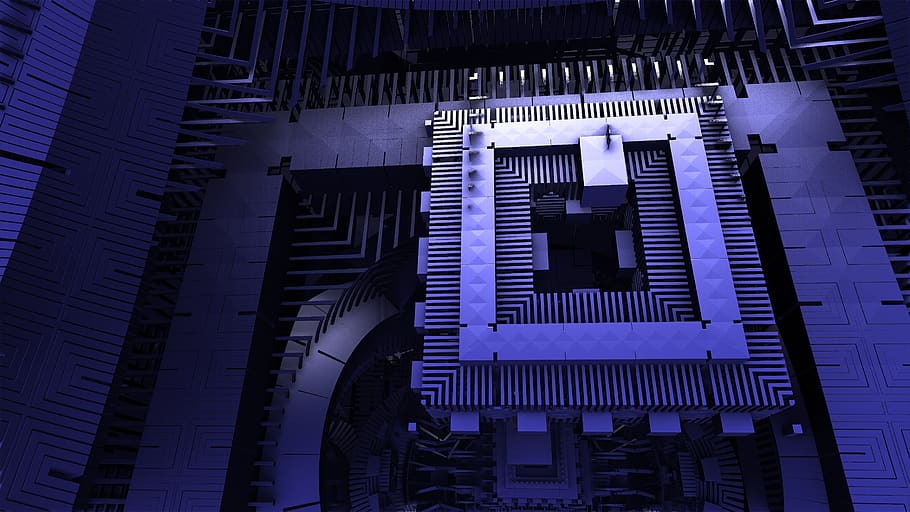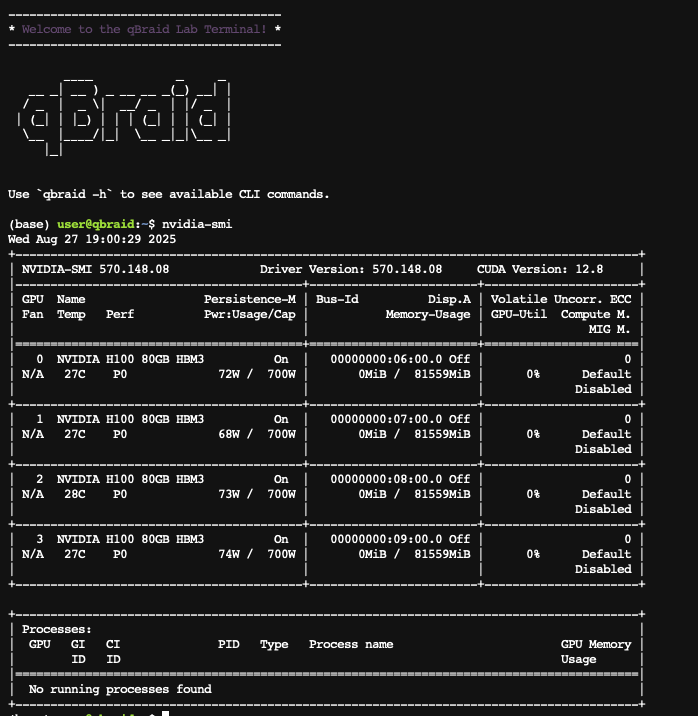Press Releases
5
Min read
Coming from IBM Quantum Lab? Learn how to start using qBraid Lab

Contents:
qBraid is making AI-driven quantum research faster, cheaper, and easier than ever. The NVIDIA CUDA-Q platform for hybrid quantum-classical computing includes new noisy-circuit simulators capable of generating mountains of training data on GPUs in minutes — and qBraid is rolling out some of the market’s lowest-cost, zero-setup GPU instances so that every student or startup can join the “AI4Quantum” wave. To prove it, the two companies are launching an AI4Quantum denoising demo and a hands-on San Francisco workshop + multi-month challenge later this year.
AI4Quantum: Why Now?
Quantum computers unlock new science, but today’s noisy qubits still hide the answers researchers need. Machine-learning models have shown early promise in cleaning up that noise, yet they crave two rare ingredients: (i) realistic, labelled training data and (ii) affordable GPU horsepower to crunch it.
CUDA-Q tackles the first hurdle by fusing NVIDIA cuQuantum libraries with a C++/Python API that can inject hardware-realistic error models to generate realistic data needed for training models. Using NVIDIA accelerated computing, we can power exact simulations of ~40-qubit circuits.
qBraid removes the second hurdle. Its cloud lab already packages CUDA-Q, Qiskit, and Cirq; now we are introducing pay-as-you-go NVIDIA A100, NVIDIA H100, and NVIDIA GH200 instances at some of the best prices on the market.
Quanta‑Bind, qBraid’s in‑house pipeline for simulating metal‑protein binding, pushed us to scale noisy quantum simulations well beyond 25 qubits. By re‑implementing the workflow in CUDA‑Q we cut the wall‑time for 30‑ and 32‑qubit circuits by almost 2× compared with an equivalent Qiskit stack (see Figure 1). The same CUDA‑Q backend now powers the demo below: a supervised model that learns to translate noisy expectation values into their noise‑free counterparts by producing data‑driven corrections. The training corpus of 600 noisy and noiseless observables was generated in minutes on a single GH200 using CUDA‑Q’s trajectory‑based noise simulator.

Figure 1: Simulation of representative quantum circuits generated by Quanta-Bind executed using both CUDA-Q and a competitor (Qiskit).
Using a custom graph attention-centered model, we achieved a >25% reduction in mean-squared error versus raw measurements on the synthetic data. The code for reproducing this experiment is available here.

Figure 2: Depiction of noisy and mitigated expectation values.
“CUDA-Q’s noisy simulator lets us quickly prototype weeks of hardware data overnight.” — Kenny Heitritter, VP of R&D @ qBraid
Starting this summer, every qBraid Lab user will be able to spin up an NVIDIA H100 80 GB GPU for just $1.50 per hour—no long-term commitment, no hidden surcharges. That rate undercuts many well-known public clouds by more than 50 percent and stands out because everything comes pre-loaded:
Why it matters for AI4Quantum. With NVIDIA H100 throughput at your fingertips and zero environment friction, you can accelerate both model training and synthetic data generation, and then push the same circuits to real QPUs—without leaving a single browser tab. In short, qBraid’s $2/hr NVIDIA H100 tier turns quantum-AI research from a budgeting headache into a coffee-break experiment.
qBraid is the definitive one-stop platform for quantum computing. As a deep-tech SAAS startup based in Chicago, qBraid provides seamless access to quantum software, quantum computers and NVIDIA GPUs through their development and deployment platform. The qBraid coding platform allows for automatic setup of difficult quantum software packages with integrations to quantum hardware provided by AWS, Rigetti, QuEra, IonQ, IQM, Microsoft, and others to provide their users the best experience doing all things quantum. The open-sourced qBraid SDK allows for turn-key access to quantum hardware where users can code in 15+ different quantum frameworks such as Qiskit, Cirq, or Amazon Braket. qBraid is on YouTube, LinkedIn, Twitter/X and GitHub. For more information on qBraid, visit https://www.qbraid.com.

Press Releases
5
Min read
Coming from IBM Quantum Lab? Learn how to start using qBraid Lab

Product
5
Min read
Accelerating hybrid workflows using Pennylane's embedded simulators with NVIDIA GPUs on qBraid Lab.

Press Releases
10
Min read
The Bloch develops quantum technology solutions for society’s most pressing problems by accelerating industry adoption to drive research commercialization, catapulting US leadership in quantum information science and technology.

Collaborations
3 minutes
Min read
qBraid has been selected by IBM to host their annual Qiskit Global Summer School for the second year in a row.

Collaborations
5
Min read
As an early adopter of the NVIDIA GH200 Grace Hopper Superchip systems, qBraid provides unparalleled access to today’s most advanced computing technologies.

Collaborations
1
Min read
Explore the advantages of cloud-based quantum computing and how it is revolutionizing research and development across various industries

Collaborations
1
Min read
Discover how quantum computing is revolutionizing enterprises, from enhancing cybersecurity with quantum encryption to optimizing complex logistics and supply chain operations.

Collaborations
5
Min read
qBraid’s quantum computing platform adds access to 256 qubit neutral atom quantum computer, Aquila by QuEra.

Collaborations
5
Min read
qBraid and Quantum Algorithms Institute partner to accelerate the pace of quantum computing in British Columbia and beyond.

Collaborations
4
Min read
The qBraid platform will allow users to play with Pulser in a matter of a few minutes.

Hackathons
5
Min read
As part of QHack, qBraid is providing the best quantum developer notebook environment experience for challengers.

Hackathons
10
Min read
From October 21st to November 5th of 2022, qBraid hosted HAQS, one of the most popular quantum computing events of the year, where participants from around the world worked on solving a total of five quantum computing challenges during the two weeks of the event.

Hackathons
5
Min read
At this year's QCHack, participants attended a week filled with amazing talks, 1:1 sessions with academic and industry mentors, and a 24 hour hackathon hosted by Stanford, Yale and Berkeley.
-min.jpeg)
Hackathons
4
Min read
The potential of the field of quantum computing is so huge that everyone in the field cannot wait for all the promises that the field holds to become a reality.

Research
5
Min read
IEEE has awarded qBraid and its collaborators 1st place for the Best Paper Award in the Quantum Algorithm Track.

Research
1
Min read
qBraid's team used hybrid classical-quantum algorithms to determine the best flight path

Research
1
Min read
Learn how classical sampling methods, such as Markov Chain Monte Carlo, can estimate truncation errors in simulating bosons on quantum computers, aiding resource assessment and result validation for quantum simulations, including applications in two-dimensional lattice scalar field theory.

Press Releases
2
Min read
qBraid wins NSF POSE grant to build open source ecosystem

Press Releases
10
Min read
qBraid and NVIDIA CUDA-Q are removing the two biggest blockers to AI4Quantum research

Press Releases
8
Min read
Our first cohort of the qBraid Alliance, a partnership with student organizations at leading universities around the country.

Press Releases
5
Min read
Coming from IBM Quantum Lab? Learn how to start using qBraid Lab

Press Releases
10
Min read
The Bloch develops quantum technology solutions for society’s most pressing problems by accelerating industry adoption to drive research commercialization, catapulting US leadership in quantum information science and technology.

Press Releases
5
Min read
Our newest podcast series

Press Releases
5
Min read
qBraid will lead a team of researchers from MIT, UChicago, Argonne National Laboratory, and QuEra to develop quantum computing solutions for studying the interaction of metals and intrinsically disordered proteins.

Press Releases
Min read
OSU uses qBraid for accessing Intel Quantum SDK

Press Releases
5
Min read
qBraid provides agnostic connections to quantum computers and simulators thanks to Amazon Braket

Press Releases
10
Min read
Duality Quantum Accelerator Accepts Six Startups into Inaugural Cohort

Press Releases
1
Min read
Take the QuBes (Quantum Beginners) course to learn quantum computing.

Press Releases
5
Min read
qBraid aims to increase accessibility to, and interoperability amongst, quantum computing resources.

Product
3 minutes
Min read
Supercharge your quantum workflows with GPUs on qBraid
.png)
Product
5
Min read
We are pleased to have presented qBraid’s Platform-Agnostic Open-Source Tools at the Quantum Computing Devroom in FOSDEM 2025.

Product
5
Min read
Accelerating hybrid workflows using Pennylane's embedded simulators with NVIDIA GPUs on qBraid Lab.

Product
5
Min read
Here are 3 ways to install python packages on qBraid

Product
2
Min read
How to install Cirq v1.2.0 environment on qBraid Lab

Product
1
Min read
Let qBraid help you take your first step into the quantum world!

Product
1
Min read
Intel® Quantum SDK is generally available on qBraid Lab for Free with no installation necessary

Product
1
Min read
Dive into the intricate interplay of the Bernoulli line and the Bloch sphere, revealing profound geometric insights into quantum state dynamics.